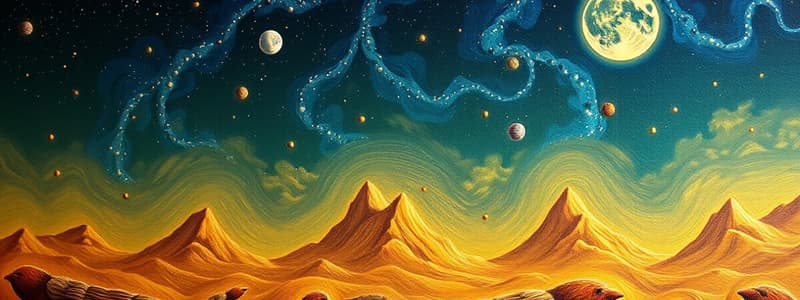Podcast
Questions and Answers
What is art according to Webster?
What is art according to Webster?
Human ingenuity in adapting natural things to man's use.
Which of the following are functions of art? (Select all that apply)
Which of the following are functions of art? (Select all that apply)
- Technical Function
- Cultural Function (correct)
- Personal or Individual Function (correct)
- Economic Function (correct)
What is one psychological factor that affects artistic works?
What is one psychological factor that affects artistic works?
An artist's psychological make-up or frame of mind.
What does harmony in art refer to?
What does harmony in art refer to?
What is rhythm in artistic terms?
What is rhythm in artistic terms?
What principle of art is demonstrated by the Mona Lisa?
What principle of art is demonstrated by the Mona Lisa?
What principle of art is demonstrated in Starry Night?
What principle of art is demonstrated in Starry Night?
What does proportion in art refer to?
What does proportion in art refer to?
Which principle of art is related to giving importance to certain parts of a work?
Which principle of art is related to giving importance to certain parts of a work?
Flashcards are hidden until you start studying
Study Notes
Exploring the World of Arts
- Art is defined as “human ingenuity in adapting natural things to man’s use.”
- Derived from the Latin word “ars,” meaning skill.
- Aristotle's concept of art includes "mimesis," referring to imitation in revealing human truths.
- Art can be interpreted through two lenses: as likeness or alteration.
Functions of Art
- Personal Function: Provides individual expression and emotional exploration.
- Social Function: Reflects and influences societal norms and relationships.
- Economic Function: Art serves as a commodity and impacts commerce.
- Political Function: Used to express political statements or critique.
- Historical Function: Chronicles events and captures cultural heritage.
- Cultural Function: Represents shared values and traditions.
- Religious Function: Often linked to spiritual expression and ceremonies.
- Physical Function: Enhances environments through aesthetic and functional design.
- Aesthetic Function: Focused on beauty and sensory pleasure in creation.
Factors Affecting Style
- Geographical Factors: Artists' locations influence their thematic and stylistic choices.
- Historical Factors: Major events shape artists' perspectives and outputs.
- Social Factors: Relationships and social contexts affect artistic expression.
- Ideational Factors: Influences from others’ ideas impact creativity.
- Psychological Factors: Artists’ mental states and backgrounds can dictate their work.
- Technical Factors: Tools and techniques used impact the style and execution of art.
- Political Factors: Influence from governments or leaders can shape artistic direction.
- Economic Factors: Resource availability significantly affects artistic creations.
Principles of Arts
- Harmony: Achieved through coherence and unity among various elements of a work, providing stability.
- Balance: Can be formal (symmetrical) or informal (asymmetrical) to convey weight and distribution evenly.
- Rhythm: The repetition of elements that creates movement and visual interest within a composition.
- Proportion: The relative size and scale of components in relation to each other and to the whole.
- Emphasis and Focal Point: Directs viewers’ attention to particular elements through size, color, or positioning.
Examples of Art Principles
- Rhythm: Found in splatter paintings (Pollock style) through repetition of patterns.
- Proportion: Illustrated in Raphael's "Marriage of the Virgin," showcasing size relationships among figures.
- Harmony: Seen in Monet’s "Water Lilies," emphasizing unity in composition.
- Formal Balance: Exemplified in "Mona Lisa," with symmetrical composition centering the subject.
- Informal Balance: Demonstrated in "Starry Night," where asymmetrical elements create equilibrium through contrast.
- Emphasis: Utilized to highlight key aspects within a work, guiding viewer engagement.
Studying That Suits You
Use AI to generate personalized quizzes and flashcards to suit your learning preferences.




